Animal Conservation or Bison Supremacism?
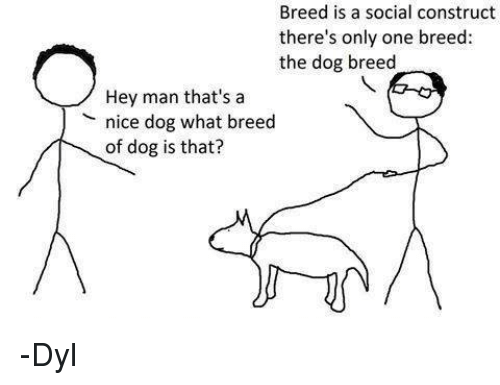
I have a general rule in dealing with the politically-correct: look at what they do, not what they say.
I was very struck when I recently came across the efforts to restore the “genetic purity” of North American bison, the overwhelming majority of which have been tainted by cattle DNA through cross-species interbreeding. While it is dogma in the humanities and social sciences that race, gender, and everything else human are social constructs with no biological basis, conservation biologists are determined to preserve the unique genetic architecture of the American bison.
The leader in the crusade to restore the genetic integrity of bison is Dr. James Derr, a geneticist at Texas A&M University. An article in Nature on Derr’s efforts had this to say:
What does it mean to save a species? For some, preserving the American bison means keeping its genome pure . . .
Derr has almost single-handedly started a movement to preserve the original bison, complete with its unadulterated genome. He has managed to persuade everyone from federal officials to private conservation leaders that they should care about the cattle genes hiding in bison. And he is convinced that his approach — managing the genome rather than the animals — could be a model for conserving other large mammals.
Most people see preserving wildlife as a matter of saving individuals; if all the individuals die out, the species becomes extinct. But that reasoning looks simplistic when considered at the genomic level. If the genes of a species change enough — through interbreeding, for example — that species will cease to exist even if individuals that look something like the original continue to thrive.
Although some species interbreed naturally, humans have forced other mix-ups, and those are the cases that most worry Derr. “Species conservation is more than skin deep,” he says. “It is more than how they look, it is how they are — that’s the genome.” . . .
Although behaviour and morphology are important, Derr contends that a species is its genome. “If you don’t have the genome, nothing else you do makes a damn difference,” he says. “What you are preserving isn’t the species; it is something the hell else — a shadow.”
There is no obligation to save every version of every gene, but wildlife managers should keep pure herds from mixing with those that have cattle genes, he says. It is a simple formulation that has caught on with a number of conservationists.
Now reread the same passage, substituting the White European genome for the American bison genome. Be prepared to be called bad names or lose your job if you do this in public.
Bison and cattle apparently split between 1 million and 1.5 million years ago, but have periodically interbred and are capable of rearing fertile cross-species offspring, which means there is no absolute distinction between bison and cattle.[1] In the nineteenth century, American bison were almost entirely exterminated, the population falling to the low hundreds. However, ranchers were able to gradually restore the population, which now numbers over 500,000. According to Derr, these descendants of ranch-raised bison are overwhelmingly contaminated with cattle DNA due to interbreeding, and the number of pure bison may be as low as 8,000 (or so he said in 2009).
So although bison and cattle are genetically close, and there is clearly a bison-cattle genetic spectrum, for Dr. Derr there is no doubt that it is meaningful to speak of “bison” and indeed of “pure bison.” He defines “pure bison” as those with “no historic or genetic evidence of hybridization.” In human terms, this would mean something like the traditional American definition of Whites under the One-Drop Rule, rather than the relatively lax definition criteria of the Nuremberg Laws (which granted half- and quarter-Jews Reich citizenship under certain conditions). He is adamant that genetic mixing leads to different animals, even if the phenotype is similar: “When you mix up two different genomes, you get a lot of different traits, and it’s not completely predictable.”
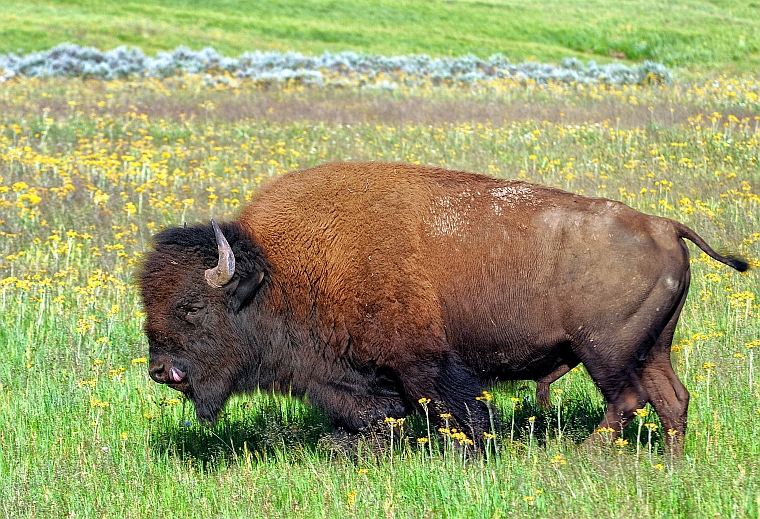
Pure American Bison, Hayden Valley, Yellowstone NP
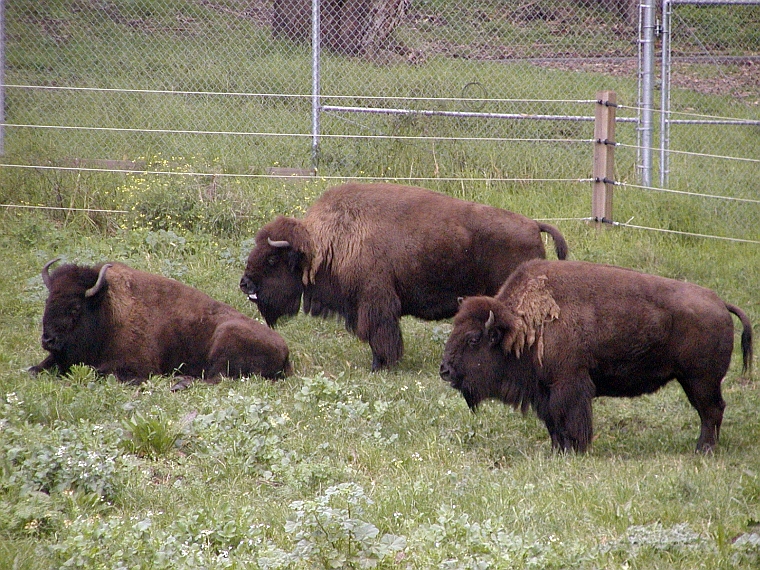
Cattle Hybrid Bison
“The differences between a species and a close hybrid are easier to distinguish when viewed side by side. Between the Yellowstone Bison and the hybrid bison some differences that are easier to pick out are shape and direction of horns, tails, and body shape and size.” (Source)
One would think that people claiming to be Darwinians would not be shocked by the idea of defining a (sub)species by its genes. However, Dr. Derr’s genetically-purist approach would have potentially radical policy implications, notably for whether a population is covered by legislation such as the Endangered Species Act.[2] If “bison” includes hybrids, this is a flourishing species, if it only includes pure bison, then this is still very much an endangered one.
One may ask: What are the other policy implications of defining a (sub)species in a genetically-purist manner? How can one restore the genetic purity of a (sub)species? The most straightforward methods are tried and tested, as Philip Hedrick sums up in an article in the Journal of Heredity. One method is to prevent miscegenation of pure bison with impure ones through forced separation: “Bison from populations with evidence of cattle ancestry should not be introduced into populations with no evidence of cattle ancestry.” Another method is to increase the pure bison population, and use these either to form new pure herds or “swamp out” cattle DNA:
Introduction of animals from herds with no evidence of cattle ancestry into herds with cattle ancestry is appropriate when surplus animals are available. This could, for example, result in a decrease of inbreeding depression, an increase of genetic variation, or even genetic swamping of cattle ancestry. In addition, excess animals from these herds without evidence of cattle ancestry could be used to establish new conservation herds by public and private stakeholders.
Finally, there is the extermination of impure bison through culling:
Reduction of cattle ancestry by culling animals with known cattle mtDNA [mitochondrial DNA] is generally appropriate and could eliminate cattle mtDNA from herds. However, such culling should not be assumed to reduce the nuclear cattle ancestry because the mtDNA and nuclear cattle ancestries are not expected to be associated, that is, to be in linkage disequilibrium. In herds with high cattle mtDNA levels, great care should be taken to retain bison variation at nuclear loci if there is selective culling to reduce cattle mtDNA.
Hedrick urges more rigorous genetic testing of bison herds to more accurately determine their degree of purity.
Derr and Hedrick’s genetic-purist arguments for species definition have not fallen on deaf ears. Across the country, bison in zoos and in the wild are being tested for their genetic purity. Montana is planning to reintroduce genetically-pure bison from untainted herds. New possibilities are also emerging through biotechnological innovation. The Bronx Zoo has been “developing a herd of pure bloodline through embryo transfer”: genetically-pure bison embryos are being implanted in surrogate mothers and pure calves are thus being born.
Bison, by the way, are not the only species which conservationists fear is being threatened by miscegenation. According to genome analysis, polar bears split off from brown bears between 479,000 and 343,000 years ago, far more recently than scientists had previously thought. In their arctic habitat, polar bears have rapidly evolved “numerous morphological, behavioural and physiological specializations for their arctic habitat, including white coat colour, a reduced hibernation regime, and a strictly carnivorous diet with corresponding changes in tooth morphology and cranial structure.” Polar bears’ evolution was “fast and furious.”
The brown and polar bear (sub?) species can and do interbreed however, resulting in populations with mixed genes. This is worrying polar bear conservationists. Polar bears are not “gaining any genetic diversity” by interbreeding with brown and grizzly bears. Rather, as one professor lamented to the Washington Post: “I hate to say it, but from a genetic perspective, it’s quite likely grizzly bears will eat polar bears up, genetically.”
For the conservationists, the imperative is clear: “We must secure the existence of purebred bison and a future for polar-bear cubs.”
But I would like to ask these genetic conservationists, as good Darwinists who recognize that humans are part of the Animal Kingdom, what implications does all this have for human societies?
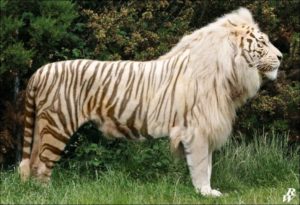
Tigon
Interestingly, tigers and lions — which split off from one another 3.2 million years ago – are still able to interbreed and produce fertile offspring called tigons and ligers. Bison and cattle split, as we have seen, between 1 million and 1.5 million years ago, while polar bears and brown bears split less than 500,000 years ago. Dogs have split into innumerable breeds through human action over the last 15,000 years, and most breeds are much younger than that. There is, I am told, about twice as much genetic diversity between dog breeds as there is between human races — a figure that perhaps makes sense if one compares the differences between a Great Dane and a Chihuahua with those between a northern European and a Congolese Pygmy.)
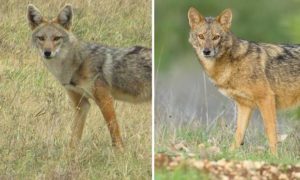
“Separate species”: African golden wolf vs. Eurasian golden jackal.
The continental human races, we are told, probably split up during a period between 200,000 and 50,000 years ago.[3] The environmental differences between the continents — especially between Sub-Saharan Africa and Eurasia/North Africa, not to mention northern Europe — are more than sufficient to cause rapid evolutionary change like that undergone by polar bears. Evolution among humans would be even more rapid, and in fact snowball, as these humans would create manmade socio-cultural environments in the form of different societies and civilizations, which themselves would select for different traits. (A Congolese colleague tells me that in Kinshasa, work stops at 2 PM, “because it is too hot.”)
It seems to me that human beings have yet to really grapple with the realities of our biological nature, even as our cultural and political elites claim to adhere to Darwinian evolutionary theory. For one, the eternal failure to achieve equality in our society is an endless source of tension — tension that would largely dissipate if we dared to recognize that individuals and populations behave differently and perform unequally in significant part because of their genes. Furthermore, if, as I believe, the human species and human societies are defined by their genes and their culture, how do we go about trying to become the best species we can be? What kind of gene pools and what kind of biodiversity do we wish to see within the human race? It seems to that political philosophers and bioethicists have much work to do on these matter, but let’s face it, eugenics and any sense of preserving the unique White European gene pool have been vilified as the ultimate evil.
Our failure to really grapple with the biopolitical implications of heredity, even as we happily indulge in plant and animal breeding, is not a new problem. The Greek aristocratic poet Theognis of Megara lamented over 2,500 years ago:
In rams and asses and horses . . . we seek the thoroughbred, and a man is concerned therein to get him offspring of good stock; yet in marriage a good man thinketh not twice of wedding the bad daughter of a bad sire . . . marvel thou not that the race of thy townsmen is made obscure; ’tis because bad things are mingled with good.
When will we, as self-proclaimed “Darwinians,” truly recognize the biological foundations of human nature?
[1] According to Wikipedia’s entry for “Bison” (accessed June 6, 2017):
The family lineage of bison and taurine cattle does not appear to be a straightforward “tree” structure as is often depicted in much evolution, because evidence of interbreeding and crossbreeding is seen between different species and members within this family, even many millions of years after their ancestors separated into different species. This crossbreeding was not sufficient to conflate the different species back together, but it has resulted in unexpected relationships between many members of this group, such as yak being related to American bison, when such relationships would otherwise not be apparent.
[2] Steve Sailer has written on the difficulty of defining discrete “species” and proposed that classification of the Pygmies as a separate endangered species could help protect them from extinction.
Pygmies are suffering from absolutely savage treatment at the hands of other Africans. In the Congo, Bantu soldiers have been gang-raping pygmies — including such humiliating ordeals as raping the village chief before his entire family and tribe — in the belief that these will give them “supernatural powers.” Africa’s population is expected to quadruple this century. “Congo soldiers raping pygmies for supernatural powers,” The Sydney Morning Herald (May 10, 2009). (Thanks to “Wilhelm” for giving me this shocking piece of information.)
[3] Actually, there are huge gaps and uncertainties in our understanding of the origins and humanity and civilization. Scientists examining 7.2 million year-old fossil remains recently suggested that humans first evolved in Europe. The remains of anatomically modern humans dating to 300,000 years ago have also recently been found in Morocco, suggesting that human evolution took place over a longer period and was more regionalized than the traditional “Out-of-Africa” theory suggests. There is also the startling discovery at Göbekli Tepe in Anatolia of enormous 11,500 year-old megaliths – far older and larger than Stonehenge – apparently built by prehistoric hunter-gatherers. It was previously thought that human beings had not achieved the necessary level of culture to build such monuments at that time.





Comments are closed.